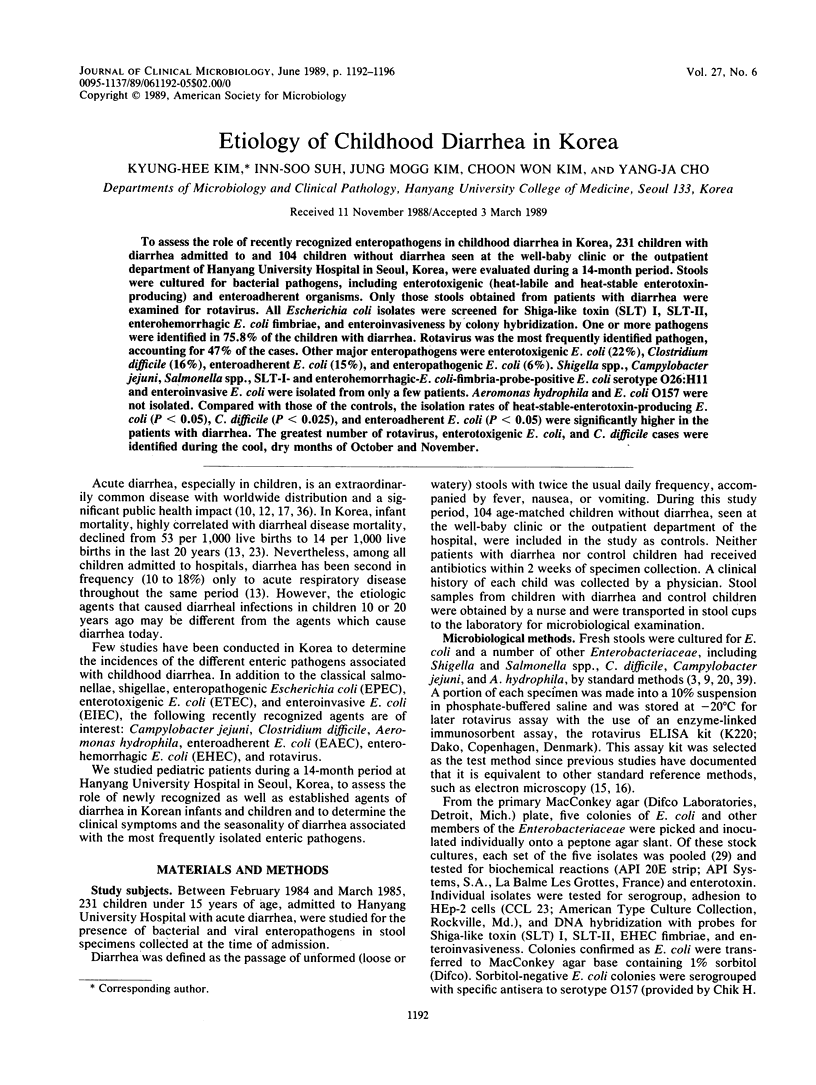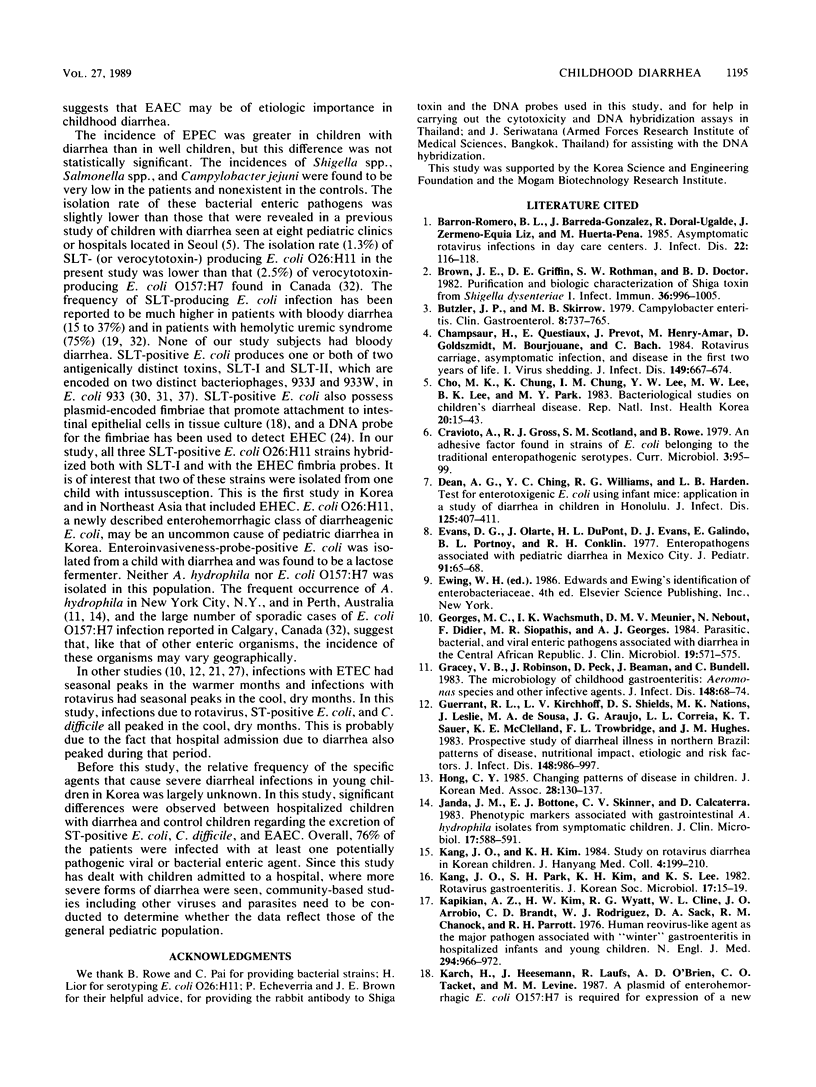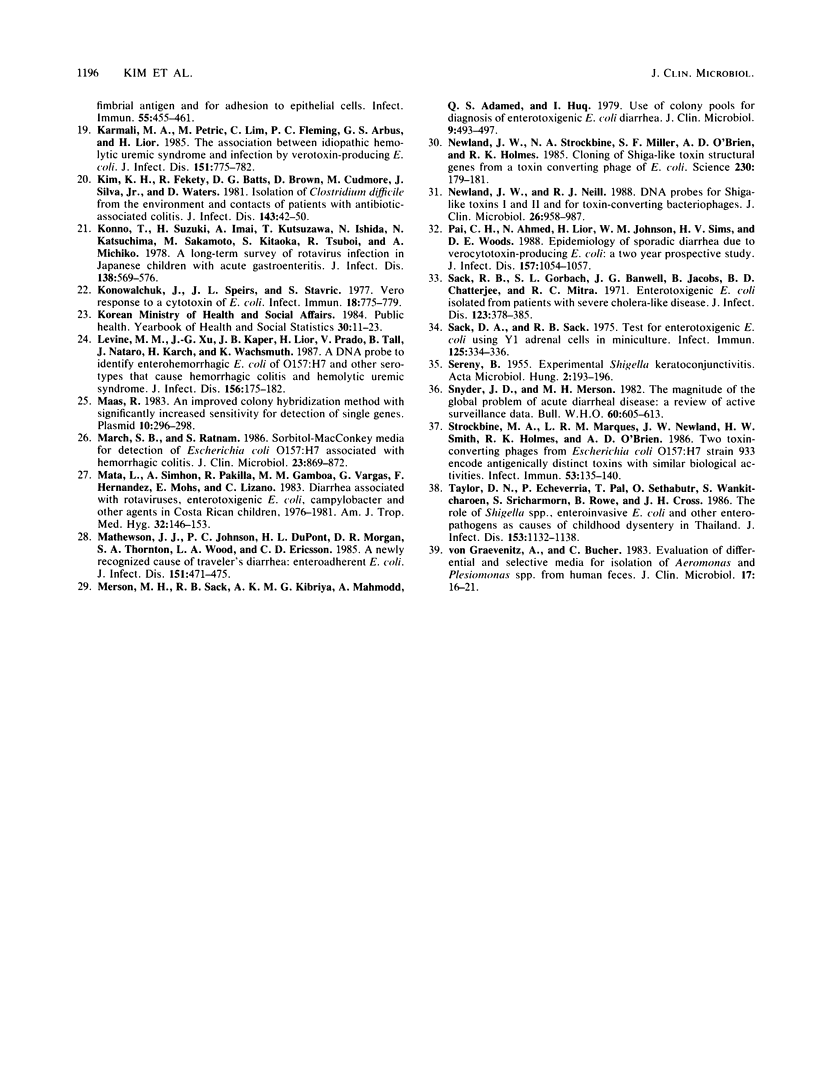Abstract
To assess the role of recently recognized enteropathogens in childhood diarrhea in Korea, 231 children with diarrhea admitted to and 104 children without diarrhea seen at the well-baby clinic or the outpatient department of Hanyang University Hospital in Seoul, Korea, were evaluated during a 14-month period. Stools were cultured for bacterial pathogens, including enterotoxigenic (heat-labile and heat-stable enterotoxin-producing) and enteroadherent organisms. Only those stools obtained from patients with diarrhea were examined for rotavirus. All Escherichia coli isolates were screened for Shiga-like toxin (SLT) I, SLT-II, enterohemorrhagic E. coli fimbriae, and enteroinvasiveness by colony hybridization. One or more pathogens were identified in 75.8% of the children with diarrhea. Rotavirus was the most frequently identified pathogen, accounting for 47% of the cases. Other major enteropathogens were enterotoxigenic E. coli (22%), Clostridium difficile (16%), enteroadherent E. coli (15%), and enteropathogenic E. coli (6%). Shigella spp., Campylobacter jejuni, Salmonella spp., SLT-I-and enterohemorrhagic-E. coli-fimbria-probe-positive E. coli serotype O26:H11 and enteroinvasive E. coli were isolated from only a few patients. Aeromonas hydrophila and E. coli O157 were not isolated. Compared with those of the controls, the isolation rates of heat-stable-enterotoxin-producing E. coli (P less than 0.05), C. difficile (P less than 0.025), and enteroadherent E. coli (P less than 0.05) were significantly higher in the patients with diarrhea. The greatest number of rotavirus, enterotoxigenic E. coli, and C. difficile cases were identified during the cool, dry months of October and November.
Full text
PDF




Images in this article
Selected References
These references are in PubMed. This may not be the complete list of references from this article.
- Barrón-Romero B. L., Barreda-González J., Doval-Ugalde R., Zermeño-Eguia Liz J., Huerta-Peña M. Asymptomatic rotavirus infections in day care centers. J Clin Microbiol. 1985 Jul;22(1):116–118. doi: 10.1128/jcm.22.1.116-118.1985. [DOI] [PMC free article] [PubMed] [Google Scholar]
- Brown J. E., Griffin D. E., Rothman S. W., Doctor B. P. Purification and biological characterization of shiga toxin from Shigella dysenteriae 1. Infect Immun. 1982 Jun;36(3):996–1005. doi: 10.1128/iai.36.3.996-1005.1982. [DOI] [PMC free article] [PubMed] [Google Scholar]
- Burke V., Gracey M., Robinson J., Peck D., Beaman J., Bundell C. The microbiology of childhood gastroenteritis: Aeromonas species and other infective agents. J Infect Dis. 1983 Jul;148(1):68–74. doi: 10.1093/infdis/148.1.68. [DOI] [PubMed] [Google Scholar]
- Butzler J. P., Skirrow M. B. Campylobacter enteritis. Clin Gastroenterol. 1979 Sep;8(3):737–765. [PubMed] [Google Scholar]
- Champsaur H., Questiaux E., Prevot J., Henry-Amar M., Goldszmidt D., Bourjouane M., Bach C. Rotavirus carriage, asymptomatic infection, and disease in the first two years of life. I. Virus shedding. J Infect Dis. 1984 May;149(5):667–674. doi: 10.1093/infdis/149.5.667. [DOI] [PubMed] [Google Scholar]
- Evans D. G., Olarte J., DuPont H. L., Evans D. J., Jr, Galindo E., Portnoy B. L., Conklin R. H. Enteropathogens associated with pediatric diarrhea in Mexico City. J Pediatr. 1977 Jul;91(1):65–68. doi: 10.1016/s0022-3476(77)80446-0. [DOI] [PubMed] [Google Scholar]
- Georges M. C., Wachsmuth I. K., Meunier D. M., Nebout N., Didier F., Siopathis M. R., Georges A. J. Parasitic, bacterial, and viral enteric pathogens associated with diarrhea in the Central African Republic. J Clin Microbiol. 1984 May;19(5):571–575. doi: 10.1128/jcm.19.5.571-575.1984. [DOI] [PMC free article] [PubMed] [Google Scholar]
- Guerrant R. L., Kirchhoff L. V., Shields D. S., Nations M. K., Leslie J., de Sousa M. A., Araujo J. G., Correia L. L., Sauer K. T., McClelland K. E. Prospective study of diarrheal illnesses in northeastern Brazil: patterns of disease, nutritional impact, etiologies, and risk factors. J Infect Dis. 1983 Dec;148(6):986–997. doi: 10.1093/infdis/148.6.986. [DOI] [PubMed] [Google Scholar]
- Janda J. M., Bottone E. J., Skinner C. V., Calcaterra D. Phenotypic markers associated with gastrointestinal Aeromonas hydrophila isolates from symptomatic children. J Clin Microbiol. 1983 Apr;17(4):588–591. doi: 10.1128/jcm.17.4.588-591.1983. [DOI] [PMC free article] [PubMed] [Google Scholar]
- Kapikian A. Z., Kim H. W., Wyatt R. G., Cline W. L., Arrobio J. O., Brandt C. D., Rodriguez W. J., Sack D. A., Chanock R. M., Parrott R. H. Human reovirus-like agent as the major pathogen associated with "winter" gastroenteritis in hospitalized infants and young children. N Engl J Med. 1976 Apr 29;294(18):965–972. doi: 10.1056/NEJM197604292941801. [DOI] [PubMed] [Google Scholar]
- Karmali M. A., Petric M., Lim C., Fleming P. C., Arbus G. S., Lior H. The association between idiopathic hemolytic uremic syndrome and infection by verotoxin-producing Escherichia coli. J Infect Dis. 1985 May;151(5):775–782. doi: 10.1093/infdis/151.5.775. [DOI] [PubMed] [Google Scholar]
- Kim K. H., Fekety R., Batts D. H., Brown D., Cudmore M., Silva J., Jr, Waters D. Isolation of Clostridium difficile from the environment and contacts of patients with antibiotic-associated colitis. J Infect Dis. 1981 Jan;143(1):42–50. doi: 10.1093/infdis/143.1.42. [DOI] [PubMed] [Google Scholar]
- Konno T., Suzuki H., Imai A., Kutsuzawa T., Ishida N., Katsushima N., Sakamoto M., Kitaoka S., Tsuboi R., Adachi M. A long-term survey of rotavirus infection in Japanese children with acute gastroenteritis. J Infect Dis. 1978 Nov;138(5):569–576. doi: 10.1093/infdis/138.5.569. [DOI] [PubMed] [Google Scholar]
- Konowalchuk J., Speirs J. I., Stavric S. Vero response to a cytotoxin of Escherichia coli. Infect Immun. 1977 Dec;18(3):775–779. doi: 10.1128/iai.18.3.775-779.1977. [DOI] [PMC free article] [PubMed] [Google Scholar]
- Levine M. M., Xu J. G., Kaper J. B., Lior H., Prado V., Tall B., Nataro J., Karch H., Wachsmuth K. A DNA probe to identify enterohemorrhagic Escherichia coli of O157:H7 and other serotypes that cause hemorrhagic colitis and hemolytic uremic syndrome. J Infect Dis. 1987 Jul;156(1):175–182. doi: 10.1093/infdis/156.1.175. [DOI] [PubMed] [Google Scholar]
- Maas R. An improved colony hybridization method with significantly increased sensitivity for detection of single genes. Plasmid. 1983 Nov;10(3):296–298. doi: 10.1016/0147-619x(83)90045-8. [DOI] [PubMed] [Google Scholar]
- March S. B., Ratnam S. Sorbitol-MacConkey medium for detection of Escherichia coli O157:H7 associated with hemorrhagic colitis. J Clin Microbiol. 1986 May;23(5):869–872. doi: 10.1128/jcm.23.5.869-872.1986. [DOI] [PMC free article] [PubMed] [Google Scholar]
- Mata L., Simhon A., Padilla R., del Mar Gamboa M., Vargas G., Hernández F., Mohs E., Lizano C. Diarrhea associated with rotaviruses, enterotoxigenic Escherichia coli, Campylobacter, and other agents in Costa Rican children, 1976-1981. Am J Trop Med Hyg. 1983 Jan;32(1):146–153. doi: 10.4269/ajtmh.1983.32.146. [DOI] [PubMed] [Google Scholar]
- Mathewson J. J., Johnson P. C., DuPont H. L., Morgan D. R., Thornton S. A., Wood L. V., Ericsson C. D. A newly recognized cause of travelers' diarrhea: enteroadherent Escherichia coli. J Infect Dis. 1985 Mar;151(3):471–475. doi: 10.1093/infdis/151.3.471. [DOI] [PubMed] [Google Scholar]
- Merson M. H., Sack R. B., Kibriya A. K., Al-Mahmood A., Adamed Q. S., Huq I. Use of colony pools for diagnosis of enterotoxigenic Escherichia coli diarrhea. J Clin Microbiol. 1979 Apr;9(4):493–497. doi: 10.1128/jcm.9.4.493-497.1979. [DOI] [PMC free article] [PubMed] [Google Scholar]
- Newland J. W., Strockbine N. A., Miller S. F., O'Brien A. D., Holmes R. K. Cloning of Shiga-like toxin structural genes from a toxin converting phage of Escherichia coli. Science. 1985 Oct 11;230(4722):179–181. doi: 10.1126/science.2994228. [DOI] [PubMed] [Google Scholar]
- Pai C. H., Ahmed N., Lior H., Johnson W. M., Sims H. V., Woods D. E. Epidemiology of sporadic diarrhea due to verocytotoxin-producing Escherichia coli: a two-year prospective study. J Infect Dis. 1988 May;157(5):1054–1057. doi: 10.1093/infdis/157.5.1054. [DOI] [PubMed] [Google Scholar]
- Sack D. A., Sack R. B. Test for enterotoxigenic Escherichia coli using Y-1 adrenal cells in miniculture. Infect Immun. 1975 Feb;11(2):334–336. doi: 10.1128/iai.11.2.334-336.1975. [DOI] [PMC free article] [PubMed] [Google Scholar]
- Sack R. B., Gorbach S. L., Banwell J. G., Jacobs B., Chatterjee B. D., Mitra R. C. Enterotoxigenic Escherichia coli isolated from patients with severe cholera-like disease. J Infect Dis. 1971 Apr;123(4):378–385. doi: 10.1093/infdis/123.4.378. [DOI] [PubMed] [Google Scholar]
- Snyder J. D., Merson M. H. The magnitude of the global problem of acute diarrhoeal disease: a review of active surveillance data. Bull World Health Organ. 1982;60(4):605–613. [PMC free article] [PubMed] [Google Scholar]
- Strockbine N. A., Marques L. R., Newland J. W., Smith H. W., Holmes R. K., O'Brien A. D. Two toxin-converting phages from Escherichia coli O157:H7 strain 933 encode antigenically distinct toxins with similar biologic activities. Infect Immun. 1986 Jul;53(1):135–140. doi: 10.1128/iai.53.1.135-140.1986. [DOI] [PMC free article] [PubMed] [Google Scholar]
- Taylor D. N., Echeverria P., Pál T., Sethabutr O., Saiborisuth S., Sricharmorn S., Rowe B., Cross J. The role of Shigella spp., enteroinvasive Escherichia coli, and other enteropathogens as causes of childhood dysentery in Thailand. J Infect Dis. 1986 Jun;153(6):1132–1138. doi: 10.1093/infdis/153.6.1132. [DOI] [PubMed] [Google Scholar]
- von Graevenitz A., Bucher C. Evaluation of differential and selective media for isolation of Aeromonas and Plesiomonas spp. from human feces. J Clin Microbiol. 1983 Jan;17(1):16–21. doi: 10.1128/jcm.17.1.16-21.1983. [DOI] [PMC free article] [PubMed] [Google Scholar]



